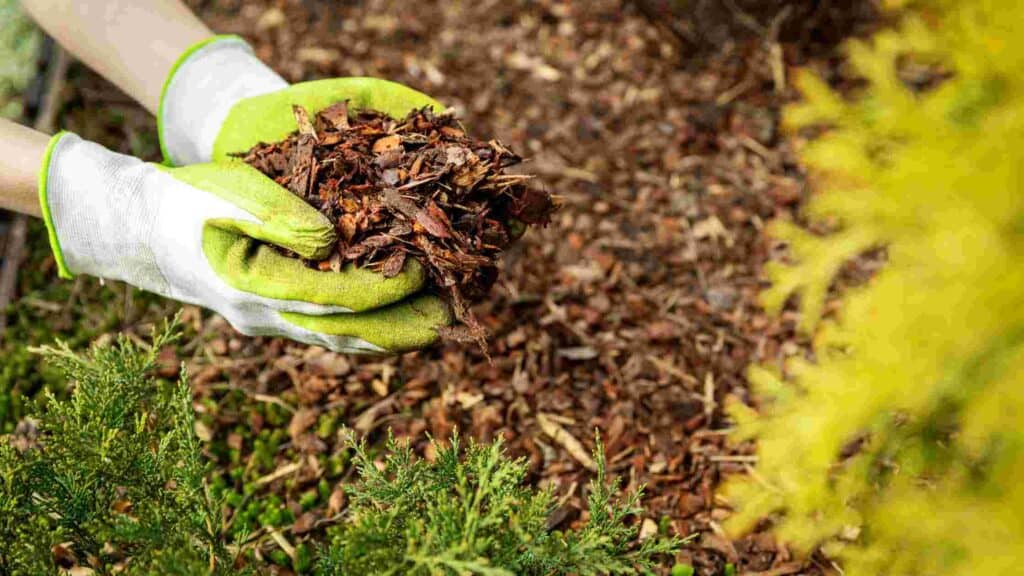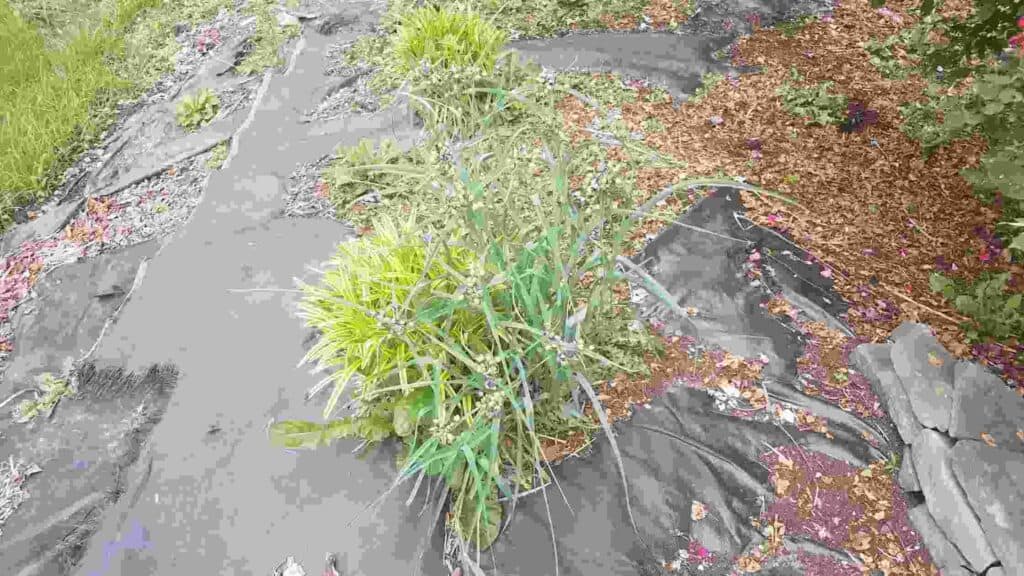If you have wondered what is mulch all about, you’ve come to the right place.
Let’s dive in and explore all things mulch, including the different types, when and where to use them, and whether you should go for the organic or the synthetic options.
What Is Mulch?
Mulch is like a protective blanket but for your garden or landscape. It can be made from either natural sources or human-made materials, and you spread it over the soil to do a bunch of great things.
First, it keeps the soil moist, which makes your plants happy. Second, it helps keep those weeds from popping up and trying to take over the garden. And third, it just makes your garden look so much better and put together!
Types Of Mulch: What Mulch Is Best?

Mulch comes in a few flavors, and they fall into two main camps: organic and synthetic. Here’s a rundown of each:
What Is Organic Mulch?
If you’re more into the natural and eco-friendly route, organic mulches are your best option. They break down over time, adding nutrients to your soil and making it easy to replace when needed.
-
- Hay: Hay can protect your soil and keep it cozy.
-
- Homemade Compost: The holy grail of organic goodness. It’s like giving your plants a nutritious meal, and they’ll love you for it.
-
- Woodchips: Woodchips are great for gardens and playgrounds alike.
-
- Compost Manure: It might not smell amazing, but your plants will adore it.
-
- Newspaper: Yep, even your old newspapers can find new life as mulch!
-
- Lawn Clippings or Fallen Leaves: The classics. Save those clippings and leaves for a natural mulch treat.
Synthetic Mulches
For all the low-maintenance gardeners out there or those who prefer a certain look, synthetic mulches might be your jam. These types don’t provide extra nutrients to the soil, but they do help lock in that moisture your plants crave.
-
- Black Plastic or Tire Shreds: These mulches are all about that modern, clean look. They work best around tough plants, like trees, but you have to be careful because they can get pretty toasty for delicate flowers. Secure them properly, or you’ll have plastic flapping in the wind!
-
- Landscape Fabrics: Think of these as the sensible shoes of mulches. They get the job done but might not be the most stylish choice. However, if you like their function and not their appearance, throw a thin layer of mulch on top to hide the utilitarian look.
-
- Gravel or Rocks: If you’re into that rugged, rocky appearance, this one’s for you. It looks cool, especially for gardens with a Mediterranean feel. Plus, it’s fantastic for good drainage.
Uses Of Organic Mulch
It’s time to explore the organic side of mulches and see what they bring to the table.
1. Hay
Hay is a fantastic mulch for your veggie and fruit beds too. Lay it down in the walkways between your plants, and you’ll have a less muddy mess to deal with.
Plus, the tiny critters like spiders will feel right at home and help keep those plant-eating pests in check (also check out: Does mulch attract bugs?).
It breaks down nicely and slowly, so you don’t have to rush out to replace it every few weeks.
Now, here’s a special mention of a hay mulch that we found to be useful—the EZ-Straw Seeding Mulch.
It’s super fine, breaks down entirely into the soil over time, and you can plop it right on top of your seeds. It helps the plants germinate faster, protecting them from birdie pecking, and keeping them from getting blown away by the wind.
2. Homemade Compost and Composted Manure
If you want to give your garden a real treat, consider homemade compost. You can either buy it ready-made or make your own compost right at home.
Just toss in all those leftover veggie scraps, fruit peels, grass clippings, and leaves. But, steer clear of meat scraps unless you want maggots in your compost pile!
When you’re planting, sprinkle a thin layer of compost in those plant holes for an extra dose of nutrients. And once your garden is up and running, use that compost as a top-notch mulch to protect and nourish your greenery.
You may also be interested in learning what to do with old mulch in the garden.
3. Woodchips
Okay, let’s talk about woodchips—aesthetically appealing and functional, a combo we can’t resist.
They’re a top pick for flower beds, surrounding trees, and beds near walkways. And you can find decorative woodchips in fancy colors like red, black, or the good old natural wood tone.
Now, one thing to remember, these chips do degrade, but they take their time doing it. So, if you go for woodchips, be prepared to replace them next growing season (recommended reading: How often should you replace mulch?).
They’re perfect for those perennial areas, but not so much for vegetable or annual flower beds. Those require more digging and maneuvering, so woodchips might not be the best option for them.
4. Newspaper
Newspaper is getting popular in the gardening world, and it’s here to stay! If you’re all about affordable and eco-friendly, this is the mulch for you. The dyes are getting more organic, and it’s a game-changer for your gardens.
So here’s the scoop—layer about 4-6 sheets of newspaper, give it a good wetting, and lay it on top of the soil.
Just like you’d use plastic or fabric, you can hide the newspaper beneath a thin layer of gravel or woodchips, and your garden will look top-notch.
5. Lawn Clippings And Leaves
Lawn clippings and fallen leaves are a treasure trove of nutrients and, best of all, right there in your backyard, waiting to be put to good use.
Sure, leave some clippings on your lawn to give it some love, but gather up any strays that have wandered onto sidewalks or roads. They’ll do wonders for your garden beds!
Here’s a power move—mix those leaves with the lawn clippings, and you’ve got yourself a nutritious mulch blend that’ll nourish your garden as it breaks down.
Uses Of Synthetic Mulches

Alright, let’s take a closer look at those synthetic mulches we mentioned earlier.
1. Landscape Plastic And Fabric
These mulches are perfect if you’re all about keeping it low-key with maintenance.
They work best around trees and hardy plants but can be a bit harsh for delicate ones. Just remember to poke some holes in the plastic or fabric, so your plants can breathe!
Watch out when the wind starts blowing because these fabrics and plastics can become quite the eyesore if they’re not secured properly. No one wants their garden turning into a plastic symphony!
2. Gravel
Gravel is visually appealing, and it’s great for plants that enjoy a bit of warmth, like those Mediterranean varieties. Plus, it’s good at drainage.
The only downside is that it’s not the easiest to move around if you decide to switch things up in your garden. And keep an eye out for any weeds trying to get into the garden.
FAQs
1. What is the purpose of mulch?
The purpose of mulch is to suppress weeds, retain soil moisture (check out the best soil moisture meters), regulate temperature, and add organic matter to the soil.
2. Is mulch just wood chips?
No, mulch can be made from various materials, including wood chips, bark, straw, leaves, and compost.
3. Is it better to mulch or not to mulch?
Mulching is generally better for garden health as it provides numerous benefits like weed control and soil improvement.
Recommended reading: When is the best time to mulch?
4. What is the best mulch for vegetable garden?
The best mulch for a vegetable garden depends on the specific needs, but options like straw, compost, or shredded leaves are popular choices.
5. What is bark mulch?
Bark mulch is a type of mulch made from shredded or chipped bark, often sourced from trees like pine or cedar.
Conclusion: What Is Mulch?
Remember, you’ve got options—organic or synthetic. While both keep those nutrients and moisture locked in, we’ve got a soft spot for the natural mulches. They’re better for Mother Earth and, most importantly, for your gardens.
If you’re concerned about garden aesthetics, decorative mulch is the way to go. For those edible beds, hay or grass clippings are a great option, giving your soil a real treat as they break down. And if you’re working up your tree areas and walkways, get yourself some landscaping fabric with a sprinkle of gravel or woodchips on top.
Whichever mulch you choose, you can bet your green thumb it’ll keep your garden lush, beautiful, and bursting with life!
